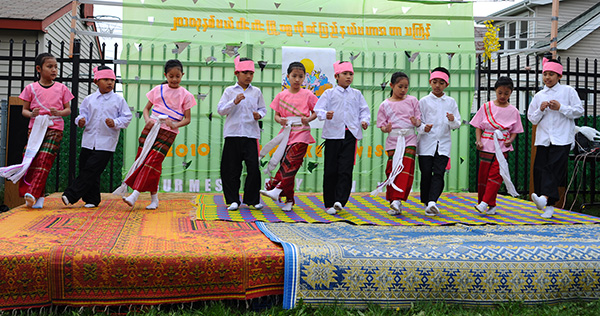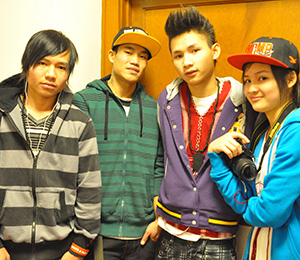
A startling 39 percent of recent refugees from Burma and Bhutan to the U.S. are high school dropouts, and 30 percent live below the poverty line.
Those are among the findings that Chia Youyee Vang details in a landmark report she co-authored and released earlier this year.
“The Burmese and Bhutanese have become the largest refugee groups coming to the U.S. in recent years,” says Vang, a UWM associate professor of history and comparative ethnic studies.

Vang and her co-author, Monica Mong Trieu of Purdue, researched and wrote “Invisible Newcomers: Refugees from Burma/Myanmar and Bhutan in the United States.” The Asian & Pacific Islander American Scholarship Fund issued the report in collaboration with the Association for Asian American Studies. The focus of much of Vang’s work is on refugees, and the association approached her because of that background. Officials wanted to learn more about these large groups of refugees coming to the U.S. and how they were faring in the U.S.
“They are coming in great numbers, but yet they were invisible in some ways,” says Vang. “Information on these two groups has been so limited, but we wanted to provide some basic background in this preliminary report so people can understand and have some general knowledge about them.” The research – “a preliminary snapshot” – was based on both published data and interviews with community members.
Different cultures, shared stress

The Burmese and Bhutanese refugees have different cultures and traditions, but those who are in the U.S. share a history of flight in search of refugee status due to tensions in their homelands. Since 2004, more than 80,000 Burmese have arrived in the United States after fleeing political, religious and economic persecution, according to the report. Refugees from the Kingdom of Bhutan, a landlocked country in South Asia located at the eastern end of the Himalayas, began coming in 2011 to escape discriminatory social and political rule.
“The primary reason is political instability in their home country,” says Vang of the Burmese.
A new regime renamed Burma as Myanmar, but many of the refugees prefer the name Burma.
“As responsible scholars, we didn’t want to take sides,” says Vang. We let people refer to the country by the name they chose.”
While the Burmese and Bhutanese have settled all over the U.S., there is a larger concentration in the South than in the Northeast and significant numbers in the Midwest, particularly Ohio and Indiana.
While warmer climates in these areas play a role, support from existing refugee resettlement groups and others in their ethnic communities are also factors, says Vang.
Language barriers, dropout rates are obstacles
The high school dropout rate of the Burmese and Bhutanese – which is twice that of non-Asian teens – is alarming because education is so directly linked to job opportunity and the ability to escape poverty, says Vang.
Many of the teens in both groups have spent years in refugee camps where they received little education. Language challenges and bullying can add to their difficulties and contribute to the high dropout rate, Vang explains.
Many of the adults in these communities are illiterate in their native languages because they grew up in rural areas of their homelands where formal education was scarce, so they are not equipped to help their children, the authors note.
The duration of life in a refugee camp is also a factor in the particular problems of the Burmese and Bhutanese refugees, says Vang.
“The length of time in the camp impacts how they view themselves and the world. Refugee camps can be demeaning environments. They are not free to move back and forth. If you are resettled in a new country after a short period of time, you struggle, but it’s not the same as living in a camp for 10 or 20 years. It’s a different kind of migration experience.”
Suggestions, signs of progress align
The authors make a number of recommendations to school administrators and policymakers based on their findings.
Vang and Trieu say that intensive educational and social support should be provided to teens to improve the likelihood that they will complete high school. “At some camps, lessons consisted of rote memorization rather than critical thinking analysis,” the authors wrote in the study. As a result, some immigrant teens don’t know how to learn and struggle to even grasp the English alphabet.
Vang and Trieu suggest that high schools train academic counselors in cultural competence about these refugee populations and step up after-school tutoring. Teens also need programs to ease their transition. They also suggest extending English Second Language Services for adults.
On the positive side, the authors found the Burmese- and Bhutanese-Americans are making some strides in higher education. For example, 23 percent of Burmese Americans hold bachelor’s degrees and another 8 percent have advanced degrees.
Vang also finds it hopeful that a number of members of Congress attended the Washington news conference about the report’s findings.
“A significant amount of work and resources are still needed to assist these two new communities, especially in the educational realm,” Vang and Trieu write. They also suggest additional studies. “Understanding a population is the critical first step to facilitating better educational opportunities, and subsequently leading to the reduction of poverty.”


